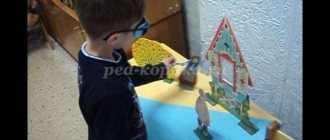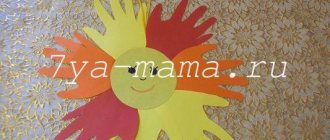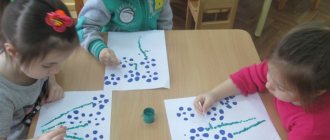Summary of a speech therapy lesson on the topic “Automation of sound [Ш] in syllables and words”
Subject:
Automation of the sound “Ш” in syllables and words.
Correctional educational tasks:
consolidate articulation and isolated pronunciation of the sound [w], continue to teach how to correctly pronounce the sound [sh] in syllables and words, learn to determine the presence of sound in words, practice the formation of diminutive nouns. agreeing nouns with numerals, dividing words into syllables.
Corrective and developmental tasks:
develop articulatory and fine motor skills, phonemic processes, breathing, attention. Memory and thinking.
Correctional and educational tasks:
cultivate cognitive interest in speech therapy classes. Positive emotional attitude to class, need for verbal communication.
Equipment:
Zvukoeshka doll, cards for characterizing the sound [w], “fizzies”; pictures on sound automation [sh], in words; didactic aids: “Speech therapy beads”, “Flowers and vases”, “Sun”, clothespins, ball.
1. Organizational moment
Speech therapist:
Hello, today we will continue to learn to speak clearly and beautifully. Let's warm up a little.
Development of general motor skills.
The naughty mice are dancing,
Some are on the cup, some are on the lid (dancing)
Hush, hush, hush, mice.
Don't disturb your little brother's sleep (walks on tiptoes)
Breathing exercise.
In order for us to do well, we will do breathing exercises. Let's take a deep breath through our nose and breathe in beauty, kindness and health, and exhale through our mouth all the grievances and sorrows. Remember: we don’t puff out our cheeks, we don’t raise our shoulders.
We inhale and exhale three times.
To be attentive and diligent, we will give you a massage.
Self-massage of the face.
Rubbing the hands (rubbing palms)
And warm up (claps)
And we wash our face with our warmth (run warm palms over the face from top to bottom)
Rake rakes away all bad thoughts (rake-like movements with fingers from the middle of the forehead to the temples).
We rub the ears up and down quickly (rubbing the ears along the edges from bottom to top and top to bottom).
We bend them forward, pull them by the lobes (bending the ears in front and pulling down by the lobes).
And then we move our fingers to the cheeks (fingers run to the cheeks)
We knead the cheeks so that they puff up (the thumb, index and middle fingers knead the cheeks in a circular motion).
We knead our lips so that we smile (the thumb and index finger knead first the lower and then the upper lip).
We lift the cheeks with the corners of our lips (raise the cheeks at the corners of our lips with our index fingers).
And then we flow from the nose to the lips (movements from the nose to the lips downwards).
We pull the chin and pinch the ears
And then we run it down the neck with our hands.
To speak clearly and beautifully, let's do some exercises for the tongue.
Remember our rule?
The eyes look and see everything,
Ears listen and hear everything,
The head thinks, and the hands help.
2. Articulation gymnastics
- We close our teeth evenly, and we get a “fence” (at the same time we connect our hands in a horizontal position),
- We smoothly rounded the lips, we depicted a “donut” (at the same time round the palms and connect them together).
Alternating the first and second exercises.
- Place your tongue with a “spatula” and hold it a little (keep your palm horizontal).
- I hold the nut on my cheek, you can’t bite it - it’s so hard
- (the left hand is straightened vertically, the right hand is clenched into a fist and rests against the left hand, then vice versa).
- Raise your tongue up and then lower it. So keep swinging... (movements with palms down and up are performed synchronously).
- Place your tongue wide, and lift the edges, turning it into a “cup” (palms take the shape of a cup).
- Take a ride with your horse and learn to click loudly. (the index finger and thumb perform movements imitating a running horse on the table)
3. Report the topic of the lesson.
A doll is brought in.
- This is Zvukoeshka. (the sound [sh] is pronounced accented)
What sound did I highlight in my voice? (sound [sh]) Today is Zvukoeshka’s birthday. We will visit her at the holiday and will continue to learn how to pronounce the sound [w] correctly.
4. Characteristics of the sound [sh] according to articulatory and acoustic characteristics.
Let's tell Zvukoshka how we pronounce the sound [w].
— When we pronounce the sound [w], in what position are our lips: rounded or stretched in a smile? (child chooses the correct card).
— Where is the tongue located: at the top or bottom?
— What shape does the tongue take: cups or spatulas?
- What sound [sh]: whistling or hissing?
- Is the sound [sh] ringing or dull?
-Is the sound [sh] a vowel or a consonant?
- Which Sounder will we designate the sound “Ш”: blue, red or green?
5. Development of phonemic hearing.
The sound girl invites you to catch the sound [sh]. This hour I will name a series of sounds, syllables and words, and when you hear the sound [w], clench your palms into fists.
Sounds:
S, X, W, Ch, Shch, F, Sh, S, X, Sh.
Syllables:
HA, SU, SHA, ZHA, FU, SHA, HO, SHO, SHI.
Words:
HUT, SOUP, TIRE, FOCUS, HAT, LEATHER, PUPPY, CANNON.
Well done, you hear the sound [sh] well, and now Zvukoeshka wants to hear how you pronounce the sound [sh].
6. Isolated pronunciation of the sound [sh].
Look at these pictures. Hiss like a snake, like an angry cat, like oil in a hot frying pan.
Zvukoeshka liked the way you pronounce the sound [w], she gives you a photo of the sound [sh] - the letter “Sh”.
7. Pronunciation of the sound [w] in syllables.
Let's make friends of the letter “Ш” with vowels. Name them. (A, O, U, I, E, Y) Collect the sun and read the syllables. (direct and reverse).
Didactic exercise “Fingers say hello”»
(all fingers touch the thumb in turn while simultaneously pronouncing the syllable “SHA” (on the right hand), “SHU” (on the left hand)
Didactic exercise "Su-Jok".
Rolling the massager over the palm while simultaneously pronouncing the reverse syllables “ASH”, “OSH”, “USH”, “ISH”, “ESH”
8. Pronunciation of the sound “Ш” in syllables and words.
Didactic game “Catch the ball, say the word.”
(Physical minute)
- A syllable and a syllable will become a word,
We'll play the game again.
The speech therapist says a syllable and throws the ball to the child, the child comes up with a word with this syllable and throws the ball back.
- Remember our rule? The head thinks, and the hands help.
Now our hands will help us, and to make it easier for our fingers to work, let's do a massage.
9. Massage your fingers with the “Cheerful Kitten” clothespin.
The silly kitten bites hard,
He thinks it's not a finger, but a mouse,
But I'm playing with you, baby,
And if you bite, I’ll tell you: “Shoo.”
10. Automation of the sound “Ш” in words.
- Zvukoeshka is sad for some reason. It's her birthday today! Let's give her gifts.
Didactic exercise “Beads”».
The child strings “beads” on a cord, on which there are pictures with the sound “Ш” (2-3 pictures with other sounds), selects the necessary ones, clearly pronouncing the words.
Didactic exercise “Flowers and Vases”.
The child gives Zvukoeshka Flowers with pictures with the sound “Ш” pasted on them, places them in vases, determining the position of the sound “Ш” in the word (at the beginning, in the middle, at the end of the word)
Didactic exercise “Say kindly».
Let's call Zvukoeshka affectionately. (Zvukoeshechka) and give her pictures, which we will also call affectionately.
11. Summary
Well done, you tried very hard today, you pronounced the sound [sh] beautifully. Thank you for the lesson.
Used Books:
- Altukhova N.G. Learn to hear sounds. St. Petersburg: Publishing House "Lan", 1999.
- Volina V.V. ABC book holiday, M: AST-PRESS, 1995.
- Volina V.V. We learn by playing, M: New School, 1994.
- Komarova L.A. Automation of the sound “Ш” in game exercises. Preschooler's album. M: Publishing house "Gnome and D", 2007.
- Lopukhina I.S. Speech therapy. 550 entertaining exercises for speech development.
Setting the sound sh
The production of the “sh” sound, namely the correction of the “sh” sound profile, depends on the reasons for which this occurs. Sometimes the correct articulation of the sound Ш occurs after a visit to the orthodontist, who, with the help of orthodontic structures, expands the upper palate and corrects the bite. If the teeth are normal or pronunciation does not improve after the dentist’s intervention, speech therapy exercises are needed. They are based on the development of the correct articulatory structure of the sound “sh”.
Correct articulation
To make the sound Ш, it is important to understand how the tongue should be placed:
- it should be wide with a raised leading edge towards the top;
- a gap should form between the tongue and palate at the upper incisors;
- at the same time, the lateral edges are in close contact with the molars of the upper jaw.
An important condition is the absolute symmetry of the language. The position of the lips is also important: they should be folded into a funnel.
Articulation gymnastics
An individual speech therapy session begins with articulation gymnastics for the sound “sh”. Articulation exercises delight children. We make the sound sh while playing:
- “Hippopotamus”: open your mouth wide, count to five, then close it.
- “Frog”: stretch your mouth into a smile without changing the position of your teeth.
- “Tube”: stretch your lips with a tube, hold them.
- “Pancake”: place a wide, relaxed tongue on the lower lip.
- “Jam”: lick your upper lip with a wide, cup-shaped tongue.
- “Brush”: move your tongue across the roof of your mouth, from your teeth to your throat.
Breathing exercises
After a set of articulation exercises, the child is asked to perform breathing exercises in a playful way:
- “Air football”: put a cotton ball on the table and offer to score a goal with an air stream from your mouth. To do this, the lips are folded into a tube, and the cheeks are not involved. Before teaching your child this exercise, you need to hold his cheeks with your fingers so that he does it with one even exhalation.
- “A butterfly sat on a flower”: cut out flowers and butterflies from colored cardboard and connect them with thread. Blow butterflies off flowers with a stream of air.





